Istanbul, Turkey
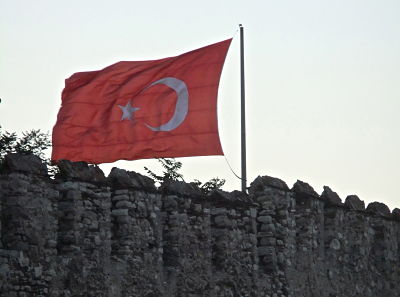
http://www.youtube.com/watch?v=JeQ-wjDH4F4
Ok, guys, repeat after me: "Istanbul (Not Constantinople)!"
We were never planning on going to Turkey at all on this trip. In fact, we had several groups from Turkey invite me to speak there and I had to turn them down because it was just one more country than it seemed realistic to reach on our already over-crowded, overly ambitious speaking schedule.
But, then, well, we discovered the only cheap way to get from Bologna to Athens was via Turkish Air, and they offered you the discount only if you had a layover in Istanbul -- no doubt a scam they have worked out with the local tourism bureau but okay, if we are going to be there anyway, we might as well extend the time a little and try to take in some of the local culture. So, we were in Istanbul for a good deal less than 24 hours, but we didn't actually sleep very much while we were there. :-)
And, the fun started just down the street from our hotel, where we saw this factory outlet store that sold discounted Magic Lamps (apparently) and also fez. We had to bring back a bright red fez for our son because we have it on very good authority (Matt Smith's Doctor, no less) that "fezzes are cool," and of course, they are.
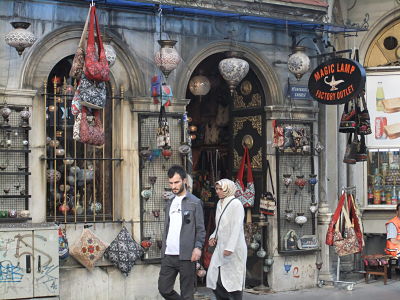
And then, of course, we felt an urgent need to eat Turkish Delight on a moonlit night (hearing a certain set of song lyrics echoing in our heads), and we discovered the enormous range of different kinds of Turkish candies on offer, most of which come in long strips, which the candy butchers snip, snip, with scissors before dropping chunks into custom-selected sampler boxes. By now, my sweet tooth is legendary all over Europe, so I was certainly not going to resist this kind of temptation.

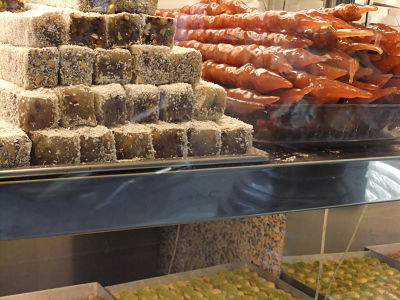
And everywhere we went in Istanbul, we would encounter these roaming carts which sold nuts and sunflower seeds. I am a closet sunflower seed fanatic -- a "seeder" as they call us on the bags that I buy in the States -- but the process of biting open seeds and spitting out the shells is not something I'd ever consider doing in public. So, I was fascinated to see so many people wandering the streets, consuming those salty little devils, and dropping their shells where-ever they happened to be standing. It would seem Seeders in Turkey enjoy many of the same rights that smokers used to enjoy in the United States. I suppose it's only a matter of time, though, before people start to protest second-hand shells.
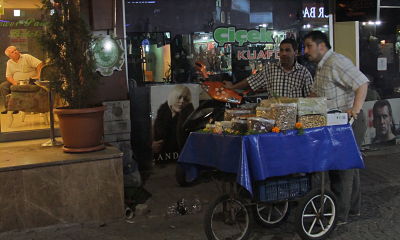
As we continued our walk, it took us through the grounds on the edge of the Topkapi Palace, the primary residence for the Ottoman Sultans and their Harem. At dusk, the Palace proper was closed, but the park grounds enjoy heavy foot traffic as families and young lovers had pick nicks on the grass, and as people wandered around enjoying the cool(er) summer night air.
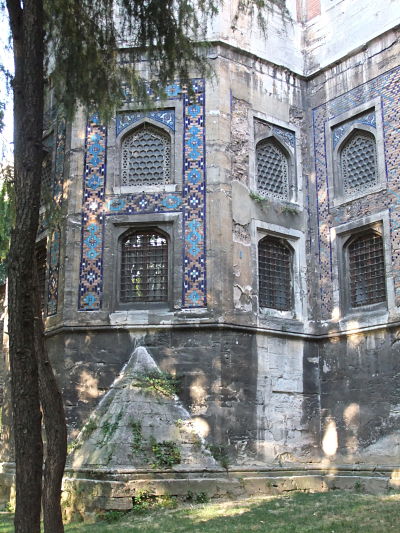
From there, our walk took us along the rocky shores of the Bosphorus River, which forms the boundary between the part of Istanbul which is in Europe and the part which is Asia. Some people were fishing along the river, some were roasting corn or meats, and still others were stopped to watch the sunset over the opposite shore.
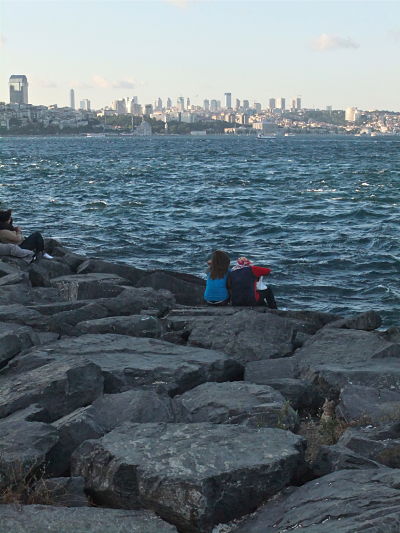
But, everywhere you looked, there were stray cats, many of the adorable kind, who no doubt live off the scraps all of those other activities left behind, especially the fishing. Of course, if they could convince the cats to eat the sunflower shells... but that's another story. Anyway, some one told me that cute cat pictures were popular on the web, so I decided to share a few of them here.
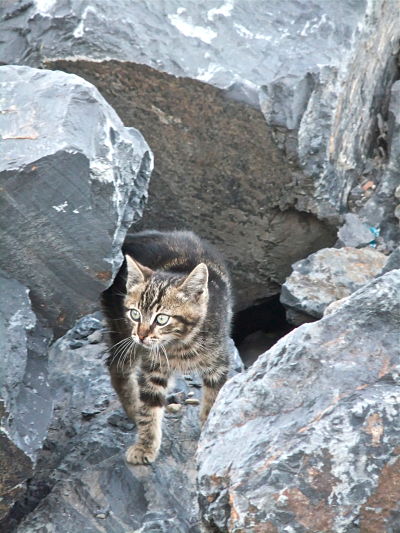
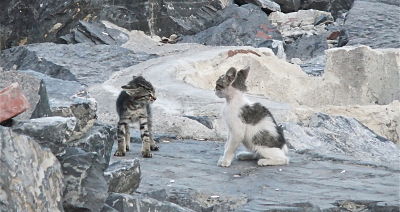
After a late night dinner in a local cafe, as we watched the closing Euro-Cup game, we grabbed a few hours sleep and then we were at it again the following morning, when we visited the Sultan Ahmed Mosque (popularly known as the Blue Mosque), one of many outstanding examples of Islamic architecture to be seen in this historic city.
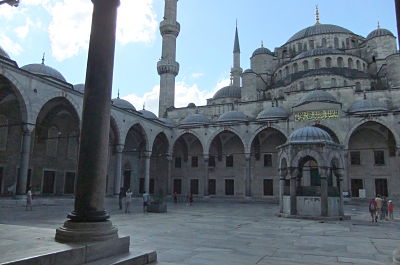
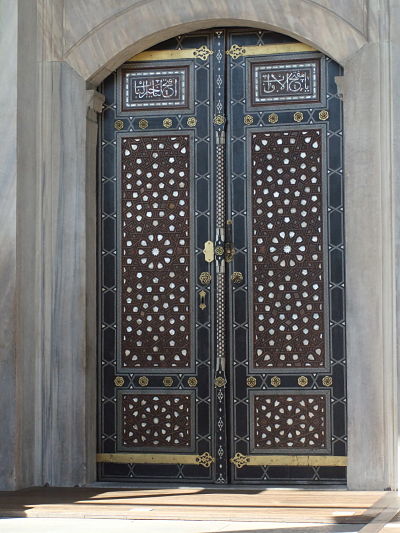
And, while we were exploring, we stumbled onto several more examples of the kind of warning sign slapstick we've been tracking across the trip. Here, for example, is a sign which seems to be warning us to beware of people who have really big black hands.
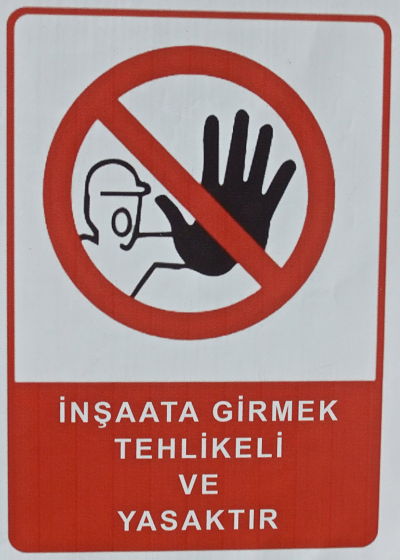
While this image would appear to either warn us that hooks will come from the sky and carry us away, or perhaps, the sign is meant to suggest that it is a trapeze artist crossing zone.
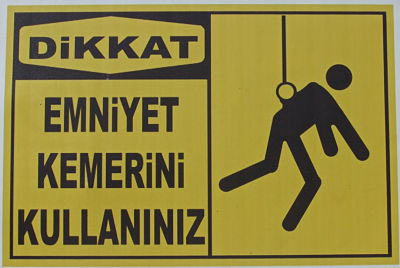
But, then, I might be misunderstanding something. I've been told for years by European that their more concrete signs, which take advantage of a universal pictorial language, do not require specific cultural knowledge, unlike our more abstract American signpost. Is it possible that, in fact, these pictures do require a certain amount of interpretive work before they make sense to people who do not come from that culture?
We lingered as long as we dare, taking in as much of Istanbul, as our very limited schedule allows. I promise my friends in Turkey that we will find a way to get back there again before much longer, and this time, we will actually let you know we are coming so we can schedule some talks.
KEA,GREECE
The thing you need to know about that day was that we had to be at the Lavrio docks by a certain time in order to take a ferry out to Kea, a small island off the coast of Athens, where my friend and colleague, Andrew Horton, owns a cottage. (Horton is among other things a media scholar who writes about Greek cinema, screenwriting, and especially film and television comedy. I wrote an essay about Mel Brooks which will come out in A Companion to Film Comedy Horton edited with Joanna Rapf, which is due out in November. Horton runs an exchange program which brings American screenwriting students to Greece to learn from some of the country's leading filmmakers, having made Greece a home away from home for most of his professional life.)
They only run the ferry a few times a day and this was going to be the last one for the night. Cynthia, my son, and I enjoy watching The Amazing Race together, so the program had become a key reference point for us all trip. The cameras on the program never show the contestants having to go through customs, opening up space to describe all of the other aspects of international travel they don't tell you about on American reality television. This day proved to be a particularly challenging one, full of obstacles of all kinds. There was a mad rush to the airport, followed by a huge line, flight delays, a flight to Athens, delayed bags, struggles to change currency, and then, by this point, it looked like there was no way we were going to get to the ferry on time. So, we sat in the back of a cab, which was racing towards the waterfront many miles away at a breathless speed, and my wife and I were rehearsing our confessionals. It's a staple at such moment on Amazing Race for contestants to reassure each other about how much it has meant to them to share this time together and see the world, even if they were unable to complete the race, and we were making jokes about being eliminated the minute we stepped outside the cab. As it happened, thanks to the reckless disregard for human life displayed by our taxi driver, we made it to the ferry station with minutes to spare.
Let's just say that Kea was everything I might have ever imagined a Greek fishing town to be like: the waters of the Aegean Sea are as blue, the churches are as white, the people are as friendly, the terraces are as steep,as anything I've ever seen in a travel brochure or a movie about coastal Greece.
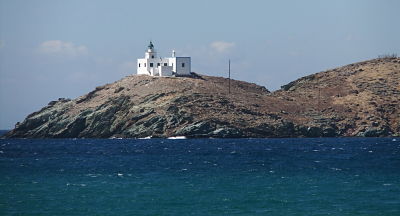
We had Andrew's cottage to ourselves for several days, during which, for the most part, we slept. I have joked that our experience on this Greek island was very much modeled on the Lotus Eaters sequence in Homer's The Odyssey. Grapes grow off his roof, and we could see the fishing village spread out below us.
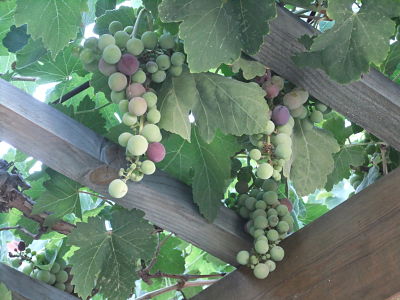
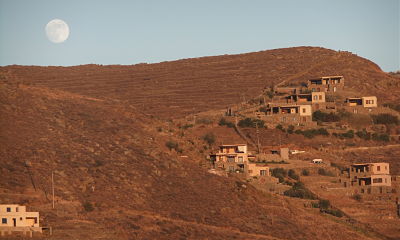
We would walk down the hill twice a day to eat, then climb back up the steep, winding, path, and plop back down in the bed again.
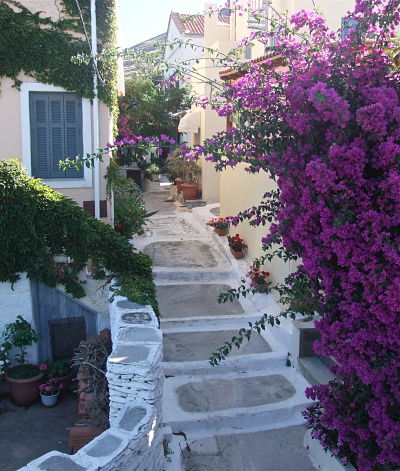
Sometimes, we read or watched movies from his large dvd library, but to be honest, we mostly slept. By this point in the trip, I was that tired and the island was that restful.
ATHENS, GREECE
For much of the trip, we had been speculating about what the political and economic state of Greece would be by the time we got there. The Greek elections had only just occurred, and depending on the outcome, there had been much speculation about whether the Greeks might abandon the Euro, unwilling to accept the austerity measures being proposed by the leadership of the European Union. Greece had been one of the countries hit the hardest by the economic crisis, and it was not hard to see the signs of their desperate conditions everywhere you looked. Basic city services seemed to have been cut to the minimum, with the result that streets were lined with garbage and buildings were becoming overwhelmed with graffiti.
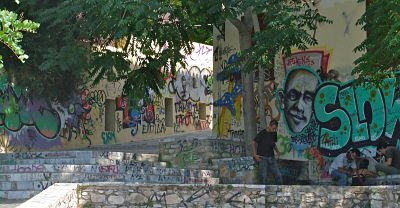
There were jobless and homeless people everywhere, and their plight was summed up for us by a particularly vocal old woman who seemed to be declaiming about the fates in an oratorical style that would have done her ancient ancestors proud. I have no idea what she was saying, but she hit my heart strings pretty hard, just with the rising and falling pattern of her voice, as she shouted and shouted into the face of a seemingly indifferent city.
Athens was hot -- hot as Hades! Even first thing in the morning, the sun bears down mercilessly on the Acropolis, and the reflections off the white marble of the Parthanon are blinding.
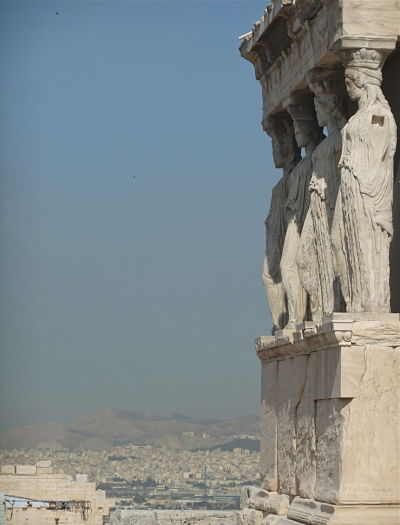
There is a classical legend about a battle between Athena and Poseidon to determine which God would rule over the Acropolis. Poseidon smote the rock with his trident and out sprang a fresh water spring. Athena, however, made olive trees grow and won the competition. We've argued that Poseidon got cheated: the olive trees really do not provide much shade on a hot day and everyone we saw on top of the mountain was carrying bottles of water. But, then, it looks like Hades rules over all, at least in the summer.
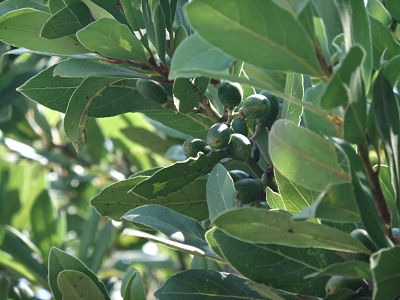
Here, you see the Temple of Hephastus and the Greek Agora, the other essential site for the tourist wanting to experience the world of Ancient Athens.

By the way, a funny thing happened to us on the way to the Forum. Cynthia and I were sitting on a bench in the shadow of the Temple of Hephastus, who, you will recall, was the blacksmith and engineer of Olympus, when all of a sudden we hear someone calling my name. It turned out to be Andy Lipmann, Michael Hawley, and a bunch of other faculty, staff, and students from the MIT Media Lab. I learned later that they were in Greece to attend Nicholas Negroponte's wedding. This was somehow the least likely and the most likely place to run into folks from MIT on the entire trip!
In a museum on the grounds of the Greek Agora, which some have described as the birthplace of democracy, we were intrigued to see some examples of the kinds of ballots used for voting in classical Athens. As you can see, they are little clay discs onto which were scratched the name of the candidate that each voter supported. Candidates, we were told, often created many such discs and passed them out to the voters as part of the campaign process.
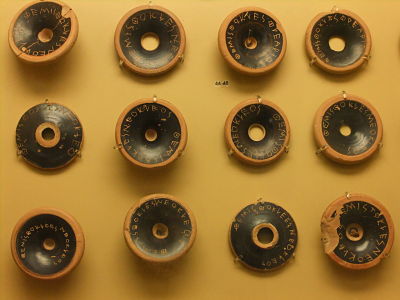
These other two artifacts were found inside the National Archeological Museum. The first is an example of the kinds of masks worn by performers in the greek theater -- in this case, this is a grotesque buffoon of the kind who might appear in a Greek comedy.
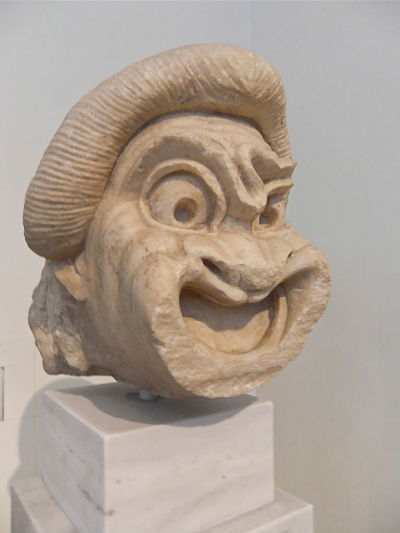
And this is a marble statue of Hermes found in Siphnos. The sign explains, "Hermes was, among other properties, the patron of travelers, therefore herms were erected at roads and crossroads. The Phallus carved not the front face of the pillar is both a symbol of pleasure and an apotropaic element." In case you are wondering, apotropaic means that it was designed to ward off harm and evil influences, or to bring good luck.
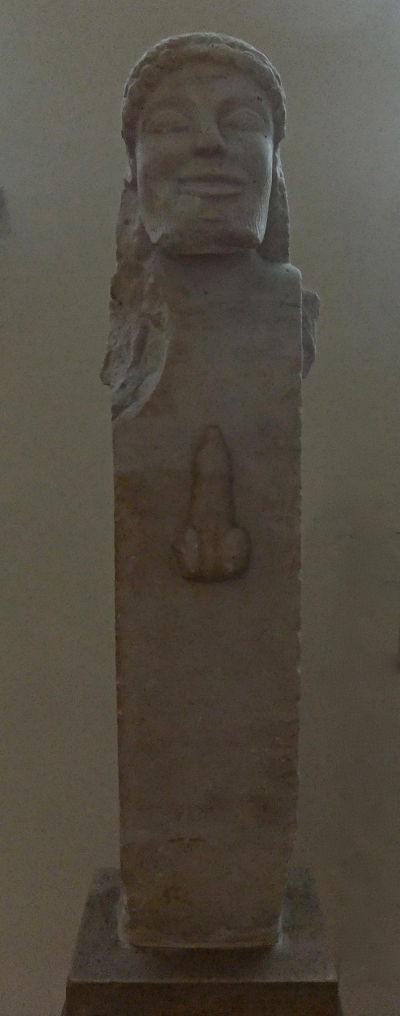
I was hoping that Hermes would watch over us as we began to get ready for our return to the United States.
I mentioned last time that I was starting to spend more and more time hanging out in Mickie D's in Europe. As I did so, I started to develop some interest in the processes of localization and the ways that the franchise has begun to adjust its menu to reflect cultural differences in regions around the world. Here, for example, is a sign for the Greek Mac (spotted in Athens). As you can see, if you look closely, the Greek Mac consists of two hamburger patties wrapped in Pita bread, with yogurt sauce, tomato slices, and onions.
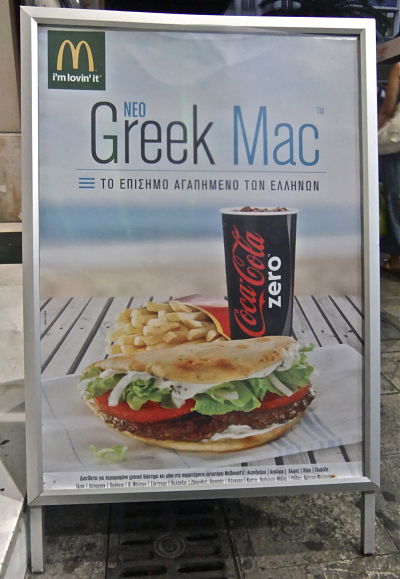
Below it, there's a sign for Il Mac (as seen in a fast food establishment in Rome.) which uses parmesan cheese.
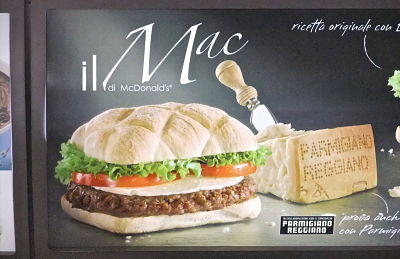
And in Paris, we saw people eating the McBaguette -- the name tells the whole story, but here's a news clip announcing its debut, which I found on the web.
So, maybe Quentin Tarantino was onto something when he has his gangster protagonists in Pulp Fiction exploring the cultural nuances of what's on the fast food menus of Europe. Just thought you'd want to know.
ROME, ITALY
http://www.youtube.com/watch?v=zwmSMwXIkZQ
It used to be said that all roads lead to Rome. In our case,our entire grand tour of Europe ended up there. Cynthia and I had been boning up for this leg of the trip by working our way back through our boxed set of dads from HBO's Rome, not to mention Audrey Hepburn in Roman Holiday, at night in our hotel rooms. Rome is of course much to vast and diverse a city to do justice to within a few days time, and its culture spans most of written history. We made a conscious decision that this trip we were going to focus primarily, if not exclusively, on Ancient Rome, and would hold off on Renaissance and Catholic Rome for future adventures.
But, first, I need to do two final presentations. First, I gave a live webcasts to librarians and information officers working in U.S. Embassies around the world as part of their "Window on America" series. After some brief opening remarks, the program's host asked me to respond to questions sent by Twitter from many different countries, primarily focused on the impact of new media on learning and literacy, on books publishing, and on civic and political participation.
Later in the trip, I had a chance to sit down and talk with David H. Thorne, the current U.S. Ambassador to Italy, and a key member of the Obama 2008 campaign, where we had a great exchange about the impact of new media on American electoral politics.
The U.S. Embassy also underwrote my talk at the European Institute for Design, which was hosted by Max Giovagnoli. Max has run the Ted X Transmedia conference in Rome. Here's a video of Max talking about his own work as a transmedia designer.
http://www.youtube.com/watch?v=zmsXIGwEQz8
He is also the author of Transmedia Storytelling: Imagery, Shapes, and Techniques, which takes a theoretically informed perspective on the challenges designers face in seeking to construct a transmedia narrative. Max was a most agreeable host who, even after listening me drone on for several hours about my research, and taking us out to dinner, was nice enough to take Cynthia and I for a midnight tour, which offered us an amazing vista of the ancient Roman ruins.
The school had hired a translator who was used to working with diplomats and so was incredibly slow and precise, which drug out my talk past the breaking point, probably for everyone involved, but the audience was incredibly polite and patient, leaving quietly if they needed to do so, but a high percentage of them stuck it out to the end of the presentation.
While we were visiting the design school, I had a chance to review some of the amazing works being done by their students, who are working with games, transmedia, comics, and video/film production, and often making playful use of images and techniques from global popular culture. If you follow this link, for example, you can see a dynamic public art project developed in collaboration with Warner Brothers to mark the release of the Amazing Spider-Man movie in Rome. After all of the many Spider-Man sightings on this trip, I am convinced that Spidey represents the modern day equivalent of Hermes, the Patron of Travellers. I also did a video interview which recently made its appearance on the web.
http://www.youtube.com/watch?v=LLe_VWsqS9o&feature=youtu.be
http://www.youtube.com/watch?v=kuwFDnDC4bI&feature=youtu.be
Getting into the spirit of my ongoing exploration of slapstick signs in Europe, Max recently shared with me this especially vivid "No Entry" sign located near the entry to the IED.

We then had two days, more or less, to play tourists in the ancient Roman empire, and we decided to split it between seeing the sights in Rome proper and taking a day trip out to Pompeii. Here, you see me standing in front of what is probably Rome's most recognizable landmark -- the Colosseum.
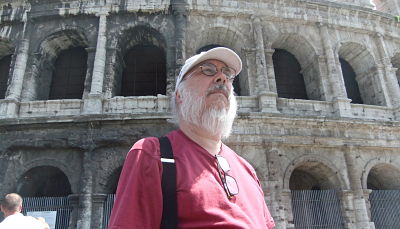
We quickly discovered that warning signs in the ancient world are as hysterically funny as their modern day counterparts. Here's a sign, for example, inside the colosseum, which I suspect was intended as a warning for visitors not to try to feed or pet the Tigers.
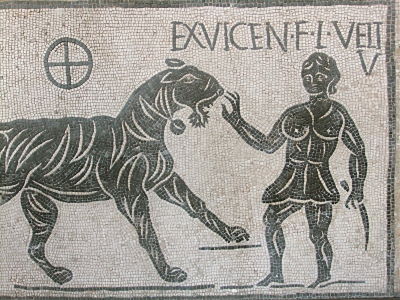
And here's a mosaic which Cynthia saw at an exhibition on glassblowing in the ancient world which seems to be offering a similar message about the risks of trying to get too friendly with crocodiles.
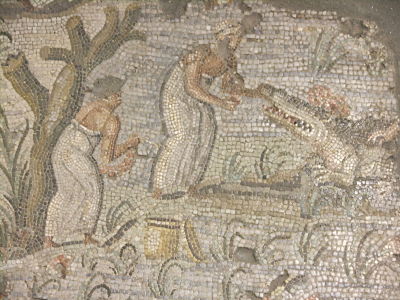
And finally, here's a "Beware of Dog" mosaic from the entry way to a house in Pompeii. It actually says "Beware the Dog" in Latin, though the letters are hard to see here, as they have faded through time.
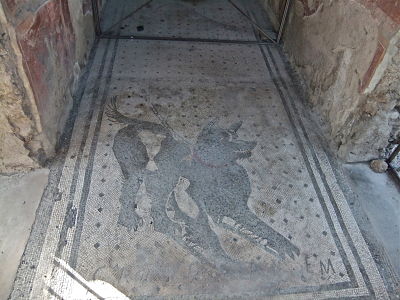
The message I took from all of this was that the ancient world was encountering creatures from all over the world, but they had not yet figured out that a great many of them bite.
While we are talking about animals, here's another gratuitous cat picture, this one taken amongst the ruins of the Baths of Diocletian.
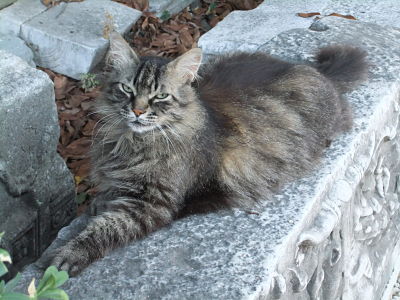
We saw brides and grooms wandering around a good chunk of Europe, including in front of the Eiffel Tower in Paris, on the grounds of Versailles, under the bridge of Sighs in Venice, and I could have filled an entire blog post just with pictures we took of loving young couples, but somehow, this image of a bride and groom walking in to the future together, captured near the Roman Forum, was too special to resist.
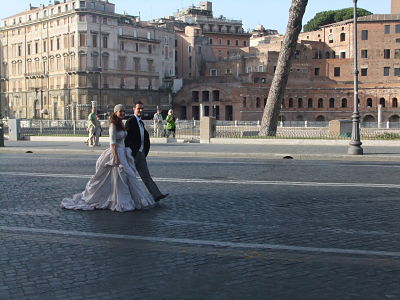
I have always been interested in Trajan's Column since Scott McCloud described it in Understanding Comics as an important predecessor of the sequential arts. A series of carvings depicting the he epic wars between the Romans andDacians (101–102 and 105–106 AD) spiral around the 98 foot tall column. It's hard to tell from what vantage point anyone could actually process the sequence of images, but McCloud argues, convincingly, that they break the action into a series of panels, which then are laid out sequentially, so that we are invited to read across them to construct the narrative.
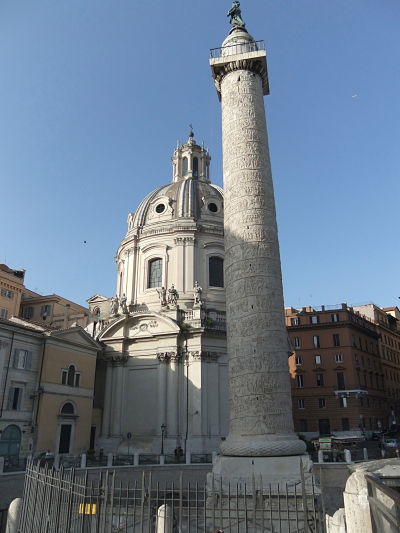
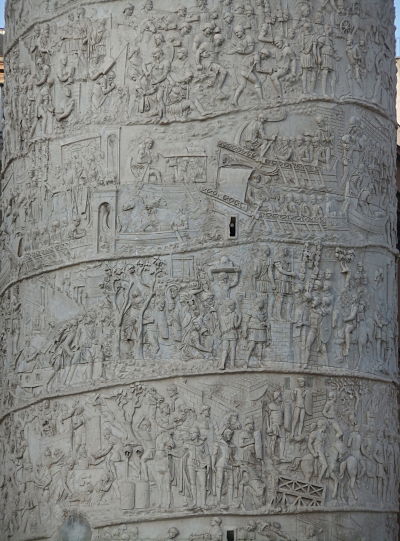
This memorial is not from ancient Rome, but it's a great illustration of the ways that subsequent Italian governments sought to mobilize the glory that was once Rome to create its own powerful myths of national origins. Constructed between 1885 and 1911, on the northern slope of the Capitoline Hill, Il Vittoriano manages to take every cliche about ancient Rome and pile them together to create one massive spectacle.
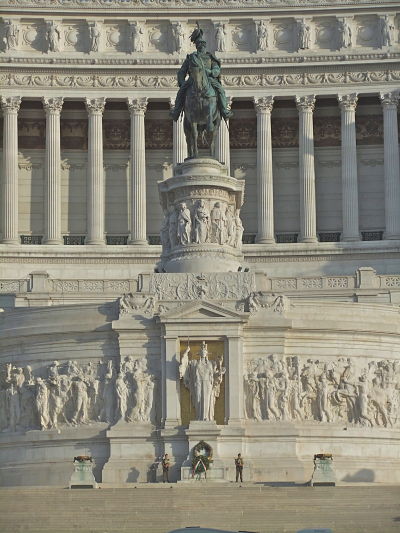
While wandering around the various museums dedicated to antiquities, we stumbled upon this wonderfully complicated looking Coffee vending machine. We all know how much the Italians love their coffee, but this seems to be a coin-operated equivalent of Starbucks, allowing you to order an astonishing array of hot caffeinated beverages.
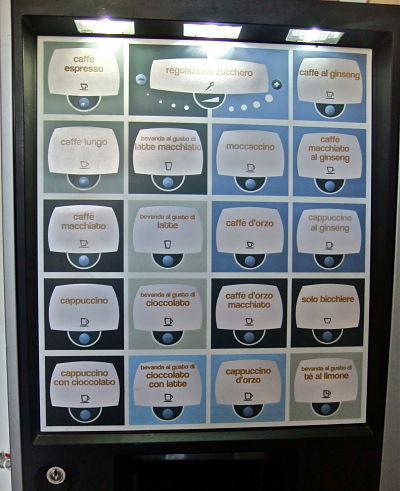
POMPEII, ITALY
The following day, we made our way by train out to Pompeii. Somewhere along the way, my pocket was picked and my wallet was stolen, which I only discovered while I was wandering around inside the ancient ruins, so we ended up having to sit up most of the night before we left to head back home on the phone canceling credit cards (or trying to do so) and dealing with various bureaucracies, and then, trying to figure out how we were going to pay for our hotel room and our cab to the airport. It was needless to say not the most fun we had on the trip. Ironically, we made it all the way across Europe without losing a bag, only to have our luggage get significantly delayed flying into LAX, and we only had to deal with robbers our last day abroad. We must have done something to cross Hermes (or Spider-man, depending on which is now the operative deity for international travelers.)
It's hard to imagine a better last place to visit in the grand tour than Pompeii, this ancient Roman city, which was partially burried by the eruption of Mount Vesuvius in 79 AD. It has both haunted (and titilated) visitors for several hundred year's now, and it offers us a unique window into the everyday life of the ancient Roman empire. Ironically, given the massive destructive force the volcano unleashed on its residents, Pompeii remains much better preserved than the ruins in Rome or Athens, both of which were subjected to human vandals through the years. Nothing I had read about Pompeii prepared me for the scale.
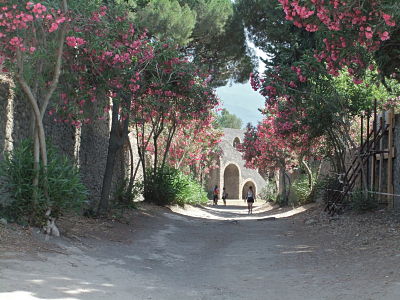

We spent an entire day wandering its streets, walking into one house or business establishment after another, from the fast food restaurant depicted here (with its multiple ovens for cooking food for commercial dining) to the public baths and the brothels (with the very explicit erotic art which scandalized the Victorians and has been tourist bait ever since.)
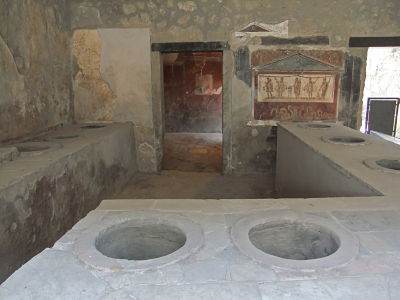
Part of what I will carry away with me are the brightly (even garishly) painted walls
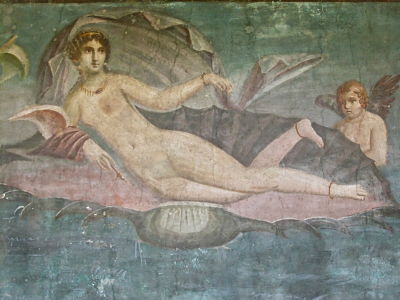
and the well preserved murals, which give us a taste for the aesthetic sensibilities of the different classes which lived together in Pompeii.
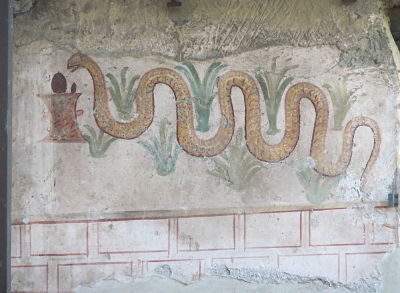
As we were leaving Pompeii, we walked past a warehouse where the archeologists store some of the assorted old artifacts they are working with -- including a large number of Amphora, and in this case, one of the plaster bodies left behind by the city's human inhabitants. These casts were created by pouring plaster into the large number of air holes left in the volcanic ash around Pompeii, which turned out to be the airspace left behind when the victim's bodies decayed. These casts offer us an incredible glimpse into the human pain and suffering that the eruption wrought on the residents of this once great city. I had seen Voyage in Italy at the Bologna Film Festival, which has a remarkable sequence showing the casting process, which gave me an even more vivid understanding of what we were looking at here.
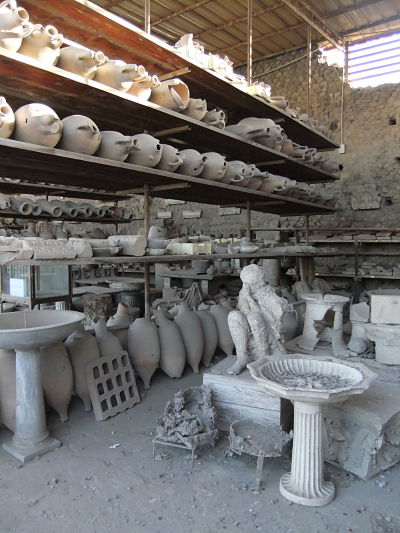
And this concludes Henry and Cynthia's Excellent Adventures. We will now return you back to our regularly scheduled blog posts.
THE END


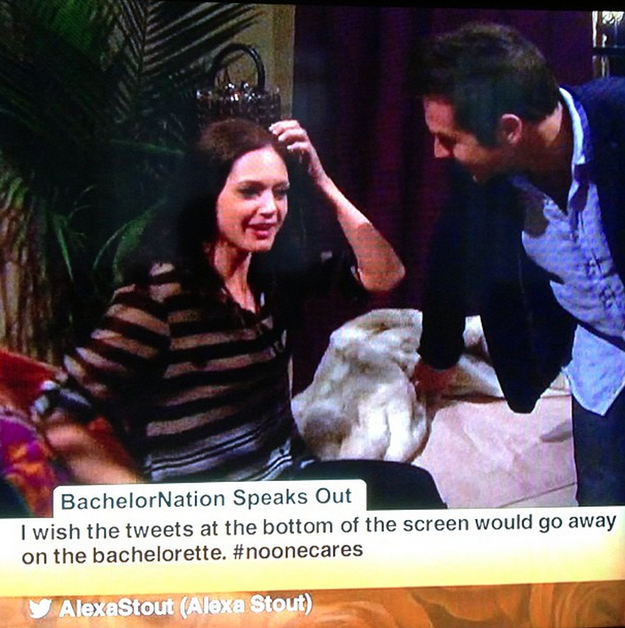
 Katie Walsh is a writer, critic, academic, and blogger based in Los Angeles. She has contributed film reviews, TV recaps, and interviews to the
Katie Walsh is a writer, critic, academic, and blogger based in Los Angeles. She has contributed film reviews, TV recaps, and interviews to the 














































![Reblog this post [with Zemanta]](http://img.zemanta.com/reblog_e.png?x-id=7f013bed-6e36-4d10-a650-442b25f2639e)
 As a long-time American Idol fan, I am watching the current controversy about Sanjaya Malakar with morbid fascination. For those of you who are not following the plot, Malakar is a relatively untalented contestant who is surviving week after week as much more widely praised rivals are biting the dust. Simon Cowell this week went so far as to suggest that nothing which the producers on the show said about his performance would make any difference in the outcome of the voting: "I don't think it matters anymore what we have to say, actually. I genuinely don't. I think you are in your own universe and if people like you, good luck!"
As a long-time American Idol fan, I am watching the current controversy about Sanjaya Malakar with morbid fascination. For those of you who are not following the plot, Malakar is a relatively untalented contestant who is surviving week after week as much more widely praised rivals are biting the dust. Simon Cowell this week went so far as to suggest that nothing which the producers on the show said about his performance would make any difference in the outcome of the voting: "I don't think it matters anymore what we have to say, actually. I genuinely don't. I think you are in your own universe and if people like you, good luck!"